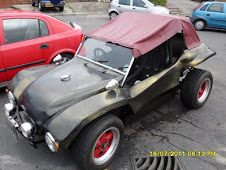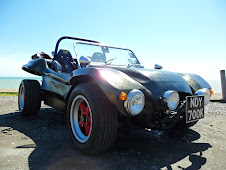 One day later.
One day later.The tank arrived finished a day later pictured left. It was cleaned up and hot flame zinc sprayed all over with a non corrosive finish. I was happy with the item especially as I was told that there where some holes shown up by the blasting process. These had been welded by AC Blastings and then the zinc spray finish had been applied. I expected the tank to fit straight into the chassis but was surprised to see that it hit the lower steering column and would not sit in its location flush. I had made some adjustments to the tank before sending it away. The GP manual states bash it with your largest hammer, I would suggest get really annoyed then take your largest hammer to it. Obviously you need to find a hammer with a good round surface something like a ball pane hammer. It is best to use a plastic one as you will find that it will not mark the tank so easily and leave a finish somewhat similar to panel beating. The process involves a lot of trial and error and finding the amount the tank moves each time it is hit . I had to ensure that the tank had at least an inch of free space. After an afternoon of hitting the tank and several beers, the tank eventually took shape and fitted.
The tank was bolted in with two bolts either side of the tank through the fibreglass. The front of the body work was situated at least 4" above the front beam axle. The tank sat just above this and it looked as if a bracket was needed to take the load of the tank onto the front beam axle. The GP manual states you need to make up two Z shaped brackets and they need to be bolted onto the front beam body mounts and then onto the bodywork. I decided that it would be a better solution to create a long beam with z brackets underneath to spread the load of the body and provide a stronger anchor point for the tank.






















No comments:
Post a Comment